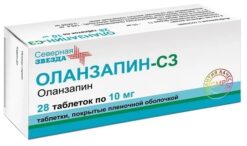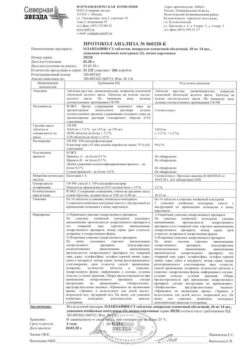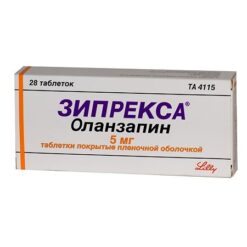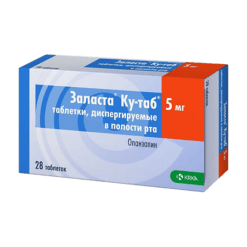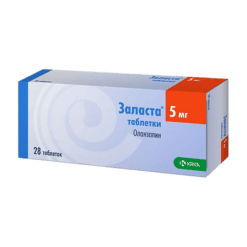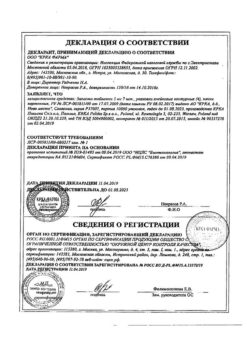No products in the cart.
Olanzapine TL 5 mg, 28 pcs.
€1.00
Out of stock
(E-mail when Stock is available)
Description
Olanzapine is an antipsychotic (neuroleptic).
Preclinical studies have established affinity for 5-NT2A/2C, 5-NT3, 5-NT6-serotonin receptors, D1, D2-, D3-, D4-, D5-dopamine receptors, M-cholin-blocking effects are due to blockade of M1-5-cholinoreceptors; also has affinity for α1-adreno- and H1-histamine receptors.
Indications
Indications
Schizophrenia.
Bipolar affective disorder type I.
Olanzapine as monotherapy or in combination with lithium or valproic acid is indicated for the treatment of acute manic or mixed episodes of bipolar affective disorder with/without psychotic manifestations and with/without rapid phase change. Olanzapine is indicated to prevent relapse in patients with bipolar disorder in whom olanzapine was effective in treating the manic phase.
Active ingredient
Active ingredient
Composition
Composition
1 film-coated tablet contains:
core:
active substance:
olanzapine 5 mg;
excipients:
Lactose monohydrate 127.0 mg,
Microcrystalline cellulose 50.0 mg,
copovidone 8.0 mg,
sodium carboxymethyl starch 8.0 mg,
calcium stearate 2.0 mg;
composition of the film coating:
Opadray II (yellow) [polyvinyl alcohol 40%; titanium dioxide 23.7%; macrogol 20.2%; talc 14.8%; iron oxide yellow dye 1.3%] 3.0 mg/6.0 mg/9.0 mg/12.0 mg.
How to take, the dosage
How to take, the dosage
Ingestion, regardless of meals, once daily.
Schizophrenia
The recommended starting dose of olanzapine is 10 mg once daily. Therapeutic doses of olanzapine range from 5 mg to 20 mg daily. Daily dose should be chosen individually, depending on the clinical condition of the patient. Increasing the dose above the standard daily dose (10 mg) is recommended only after evaluating the clinical picture. When using the drug, the need for continuation of therapy should be assessed regularly.
Bipolar disorder
For the treatment of a manic episode, the recommended starting dose of olanzapine is 15 mg once daily as monotherapy or 10 mg once daily in combination with lithium or valproic acid. Therapeutic doses of olanzapine range from 5 mg to 20 mg per day. The daily dose should be selected individually, depending on the clinical condition of the patient. Increasing the dose above the standard daily dose is recommended only after evaluating the clinical picture and at intervals of at least 24 hours.
Supportive therapy in bipolar disorder: patients who have taken olanzapine for treatment of a manic episode should continue supportive therapy at the same dose. In patients in remission, the recommended initial dose of olanzapine is 10 mg once daily. Thereafter, the daily dose should be adjusted individually; depending on the clinical condition of the patient, ranging from 5 mg to 20 mg per day.
.
Interaction
Interaction
Potential drug interactions affecting olanzapine metabolism: olanzapine is metabolized by CYP1A2 isoenzymes, therefore inhibitors or inducers of cytochrome P450 isoenzymes with specific activity against CYP1A2 may affect the pharmacokinetic parameters of olanzapine.
CYP1A2 inducers: clearance of olanzapine may be increased in patients who smoke or concomitantly take carbamazepine, resulting in decreased plasma concentrations of olanzapine. Clinical monitoring is recommended, as some cases require increasing the dose of the drug.
Potential ability of olanzapine to affect other medications
No interaction has been found with lithium or biperiden when used concomitantly.
Olanzapine slightly inhibits the formation of valproic acid glucuronide (main metabolic pathway). Valproic acid slightly affects the metabolism of olanzapine. A clinically significant pharmacokinetic interaction between olanzapine and valproic acid is unlikely. Therapeutic monitoring of valproic acid plasma content has shown that no changes in valproic acid doses are required when concomitant use with olanzapine (see section “Side effects”).
Caution should be exercised when concomitant use of other centrally acting drugs is necessary. Although a single dose of alcohol (45 mg/70 kg) has no pharmacokinetic effect, taking alcohol together with olanzapine may be accompanied by an increased sedative effect on the CNS.
Special Instructions
Special Instructions
Suicide
The risk of suicide attempt in patients with schizophrenia and type 1 bipolar disorder is due to these diseases themselves. Because of this, close monitoring of those patients with a particularly high risk of suicide is required during pharmacotherapy. When prescribing olanzapine, care should be taken to minimize the number of pills a patient takes in order to reduce the risk of overdose.
Hyperglycemia and diabetes
There is a higher prevalence of diabetes in patients with schizophrenia. As with some other antipsychotics, there have been rare cases of hyperglycemia, decompensation of diabetes mellitus, in some cases accompanied by ketoacidosis and diabetic coma, including a fatal outcome. Close clinical monitoring of patients with diabetes mellitus and patients with risk factors for diabetes mellitus is recommended.
Changes in lipid concentrations
Changes in plasma lipid concentrations during olanzapine treatment should be monitored in patients with dyslipidemia and in patients with risk factors for lipid metabolism disorders.
M-cholinoblocking activity
In clinical trials, therapy with olanzapine has rarely been associated with adverse reactions due to M-cholinoreceptor blockade. However, clinical experience with olanzapine in patients with comorbidities is limited, so caution is advised when prescribing olanzapine to patients with clinically significant prostatic hyperplasia, paralytic ileus, closed-angle glaucoma and similar conditions.
Withdrawal syndrome
The following symptoms are very rare (< 0.01%) if olanzapine is stopped abruptly: sweating, insomnia, tremor, anxiety, nausea, or vomiting.
Parkinson’s disease
Olanzapine is not recommended for therapy of psychosis induced by dopamine receptor agonists in Parkinson’s disease. In clinical studies in patients with psychosis induced by taking the drug (dopamine receptor agonist) in Parkinson’s disease, an increase in Parkinsonian symptoms was noted very frequently (â¥10%) and with a higher frequency than in the placebo group. Hallucinations were also noted very frequently (â¥10%) and with a higher frequency than in the placebo group.
Effectiveness of olanzapine in elderly patients with psychosis associated with dementia
The efficacy of olanzapine in elderly patients with psychosis associated with dementia has not been established. In this category of patients in placebo-controlled clinical trials, the fatality rate in the olanzapine group was higher than in the placebo group (3.5% vs. 1.5%, respectively). Risk factors that may predispose this group of patients to higher mortality with olanzapine treatment include age > 80 years, sedation, concomitant use with benzodiazepines, or the presence of pulmonary pathology (e.g., pneumonia with or without aspiration). There is insufficient data to establish differences in the incidence of cerebrovascular events and/or mortality (compared to placebo) and risk factors in this patient group when takingolanzapine.
Hepatic dysfunction
In some cases, olanzapine administration. As a rule, in the early stages of therapy, was accompanied by a transient, asymptomatic increase in the activity of “hepatic” transaminases (ALT and ACT) in blood serum. There were rare cases of hepatitis. In addition, there were single reports of cholestatic and mixed liver damage. Special caution is required in cases of ACT and/or ALT increase in serum activity in patients with liver function insufficiency, with limited liver functional reserve or in patients treated with potentially hepatotoxic medicines. In case of increased ACT and/or ALT activity during treatment with olanzapine, close monitoring of the patient and, if necessary, dose reduction is required. In severe hepatic dysfunction caused by olanzapine, its use should be discontinued.
Neutropenia
Malignant neuroleptic syndrome (MNS)
Convulsive syndrome
Olanzapine should be prescribed with caution in patients with a history of seizures or the presence of factors that reduce the seizure threshold. Seizures have rarely been observed in these patients when treated with olanzapine.
Late dyskinesia
General CNS activity
Cautious concomitant use of other centrally acting drugs and alcohol should be observed.
The development of risk of sudden death
Experience with clinical use of any neuroleptic, including olanzapine, has shown a similar, dose-dependent, twofold increase in the risk of death due to acute heart failure compared to death due to acute heart failure in patients not using neuroleptics.
Cerebrovascular adverse events, including stroke in elderly patients with dementia
QT interval
Thromboembolism
Venous thromboembolisms have been reported very rarely (< 0.01%) when taking olanzapine. A causal relationship between olanzapine therapy and thrombosis has not been established. Because patients with schizophrenia often have acquired risk factors for venous thrombosis, all possible other factors (e.g., immobilization) should be identified and preventive measures taken.
Dopamine receptor blockade
Postural hypotension
Postural hypotension has been infrequently observed in clinical trials of olanzapine in the elderly. As with other antipsychotics, periodic blood pressure monitoring is recommended for patients over 65 years of age when using olanzapine.
Children and adolescents under 18 years of age
Olanzapine is not recommended for use in children and adolescents under 18 years of age due to insufficient data on efficacy and safety. In short-term studies that were conducted in adolescents 13-17 years old, there was a greater increase in body weight and changes in lipid and prolactin concentrations than in similar studies in adults.
Period of treatment, caution should be exercised in activities that require concentration and high speed of psychomotor reactions.
Contraindications
Contraindications
Hypersensitivity to any of the components of this drug. Hereditary galactose intolerance, lactase deficiency, glucose-galactose malabsorption.
It is contraindicated in people under 18 years of age.
Use with extreme caution if aspartate aminotransferase (ACT) and alanine aminotransferase (ALT) activity is increased in patients with impaired liver function, limited liver function reserve or in patients treated with potentially hepatotoxic drugs. In case of increased ACT and/or ALT activity during treatment with olanzapine, close monitoring of the patient is required and, if necessary, dose reduction.
With caution, use in patients with a history of epileptic seizures or who are exposed to factors that lower the seizure threshold.
Perhaps with caution in patients with decreased white blood cell count and/or neutrophil counts due to various causes; with signs of suppression/toxic impairment of bone marrow function due to drug exposure in a history; with suppression of bone marrow function due to concomitant disease, radiotherapy or chemotherapy in a history; with hypereosinophilia or myeloproliferative disease. In clinical trials, use of olanzapine in patients with a history of clozapine-dependent neutropenia or agranulocytosis was not associated with recurrence of these disorders.
Cautiously use in patients with clinical manifestations of prostatic hyperplasia, paralytic bowel obstruction, closed-angle glaucoma and similar conditions.
There is a risk of developing tardive dyskinesia with prolonged therapy with neuroleptics. If signs of tardive dyskinesia develop, dose reduction or withdrawal of olanzapine is recommended. Symptoms of tardive dyskinesia may appear or increase after discontinuation of therapy. Given the nature of the effects of olanzapine on the central nervous system (CNS), caution should be exercised when used in combination with other centrally acting drugs and ethanol.
The safety and effectiveness of olanzapine in patients under 18 years of age has not been studied.
Side effects
Side effects
The frequency of side effects: very common (more than 10%), common (more than 1% and less than 10%), not common (more than 0.1% and less than 1%), rare (more than 0.01% and less than 0.1%), very rare (less than 0.01%).
Nervous system disorders: very common – somnolence; common – dizziness, akathisia, parkinsonism, asthenia, dyskinesia; rare – seizures in patients with a history of seizures or in the presence of risk factors for seizures; very rare – malignant neuroleptic syndromeSouthern dystonia (including oculorrheic crisis) and tardive dyskinesia. Symptoms such as increased sweating, insomnia, tremor, anxiety, nausea, or vomiting have very rarely been noted during abrupt withdrawal of olanzapine.
Cardiovascular system: frequent – arterial hypotension (including orthostatic); not frequent – bradycardia with or without collapse; very rare – prolongation of QTc interval on ECG, ventricular tachycardia/fibrillation and sudden death; very rare – thromboembolism (including pulmonary artery embolism and deep vein thrombosis).
Digestive system disorders: frequently – transient anticholinergic effects, including constipation and dry mouth; transient asymptomatic increase of liver transaminases activity (ALT, ACT, especially at the beginning of therapy); rarely – hepatitis (including hepatocellular, cholestatic or mixed liver damage); very rarely – pancreatitis.
Mechanical parameters: very common – weight gain; common – appetite increase, hypertriglyceridemia; very rare – hyperglycemia and/or decompensation of diabetes, sometimes manifested by ketoacidosis or coma, including lethal outcome; hypercholesterolemia, hypothermia.
Hematopoietic system: frequently – eosinophilia; rarely – leukopenia; very rarely – thrombocytopenia, neutropenia.
Musculoskeletal system: very rare – rhabdomyolysis.
Urogenital system disorders: very rare – urinary retention, priapism.
The skin: rare – skin rash; infrequent – photosensitization reactions; very rare – alopecia.
Endocrine system disorders: prolactin increase (clinical manifestations of hyperprolactinemia were rarely observed; in most cases normalization of prolactin levels occurred without discontinuation of olanzapine); in single cases – hyperglycemia, diabetic coma, diabetic ketoacidosis.
Allergic reactions: rare – skin rash; very rare – anaphylactoid reactions, angioedema, pruritus or urticaria.
Hematopoietic system: frequently – eosinophilia; rarely – leukopenia; very rarely – thrombocytopenia.
Others: frequent – asthenia, peripheral edema; very rare – withdrawal syndrome.
Laboratory findings: very common – hyperprolactinemia, but clinical manifestations (e.g., gynecomastia, galactorrhea and breast enlargement) are rare. Most patients had spontaneous normalization of prolactin levels without therapy cancellation. Rarely – transient, asymptomatic increase in ALT, ACT activity. Infrequent – increase in creatine phosphokinase (CPK) activity; very rare – increase in alkaline phosphatase (ALP) activity and total bilirubin. In rare cases, there have been increased plasma glucose over 200 mg/dL (suspected diabetes mellitus), 160-200 mg/dL (suspected hyperglycemia) in patients with a baseline glucose concentration of less than 140 mg/dL. Increases in triglycerides (20 mg/dL from baseline), cholesterol (0.4 mg/dL from baseline), and asymptomatic eosinophilia (isolated cases) were observed.
In elderly patients with dementia, a higher incidence of death and cerebrovascular disorders (stroke, transient ischemic attacks) has been reported in studies. Gait disturbances and falls were very frequent in this category of patients. Pneumonia, elevated body temperature, lethargy, erythema, visual hallucinations, and urinary incontinence were also common.
Worsening of Parkinsonian symptoms and the development of hallucinations have often been reported among patients with drug-induced (on dopamine agonists) psychosis with Parkinson’s disease.
There are data on the development of neutropenia (4.1%) against the background of combined therapy with valproic acid in patients with bipolar mania. Concomitant therapy with valproic acid or lithium contributes to an increase in the frequency (more than 10%) of tremor, dry mouth, increased appetite or increased body weight. Speech disorders (1 to 10%) have also been reported.
Overdose
Overdose
Symptoms: very common (more than 10%) in olanzapine overdose are tachycardia, agitation/aggression, dysarthria, various extrapyramidal symptoms, decreased level of consciousness from lethargy to coma; in less than 2% of cases delirium, convulsions occur. Coma, malignant neuroleptic syndrome, respiratory depression, aspiration, arterial hypertension or arterial hypotension, arrhythmias; in very rare cases, cardiopulmonary failure. The minimum dose in acute fatal overdose is 450 mg; a maximum dose in benign overdose (survival) of 1,500 mg has been reported.
Treatment: There is no specific antidote. It is not recommended to induce vomiting. It is necessary to carry out: gastric lavage, administration of activated charcoal (reduces bioavailability of olanzapine by 60%), symptomatic treatment under control of vital functions, including treatment of arterial hypotension and collapse, maintenance of respiratory function. The use of epinephrine, dopamine or other sympathomimetics with beta-adrenomimetic activity is not recommended, since the latter may aggravate arterial hypotension. Cardiovascular monitoring is necessary to detect possible arrhythmias. The patient should be under continuous medical observation until full recovery.
Similarities
Similarities
Additional information
| Shelf life | 2 years. Do not use after the expiration date. |
|---|---|
| Conditions of storage | In a dry place protected from light at a temperature not exceeding 25°C. Store out of the reach of children. |
| Manufacturer | Drug Technology, Russia |
| Medication form | pills |
| Brand | Drug Technology |
Other forms…
Related products
Buy Olanzapine TL 5 mg, 28 pcs. with delivery to USA, UK, Europe and over 120 other countries.


